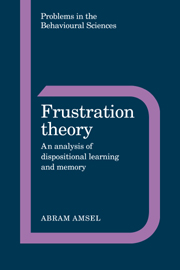Book contents
- Frontmatter
- Contents
- Preface
- List of abbreviations
- 1 Introduction: reward-schedule effects and dispositional learning
- 2 Motivational and associative mechanisms of behavior
- 3 Frustration theory: an overview of its experimental basis
- 4 Survival, durability, and transfer of persistence
- 5 Discrimination learning and prediscrimination effects
- 6 Alternatives and additions to frustration theory
- 7 Ontogeny of dispositional learning and the reward-schedule effects
- 8 Toward a developmental psychobiology of dispositional learning and memory
- 9 Summing up: steps in the psychobiological study of related behavioral effects
- 10 Applications to humans: a recapitulation and an addendum
- Appendix: some phenomena predicted or explained by frustration theory
- References
- Name index
- Subject index
3 - Frustration theory: an overview of its experimental basis
Published online by Cambridge University Press: 20 March 2010
- Frontmatter
- Contents
- Preface
- List of abbreviations
- 1 Introduction: reward-schedule effects and dispositional learning
- 2 Motivational and associative mechanisms of behavior
- 3 Frustration theory: an overview of its experimental basis
- 4 Survival, durability, and transfer of persistence
- 5 Discrimination learning and prediscrimination effects
- 6 Alternatives and additions to frustration theory
- 7 Ontogeny of dispositional learning and the reward-schedule effects
- 8 Toward a developmental psychobiology of dispositional learning and memory
- 9 Summing up: steps in the psychobiological study of related behavioral effects
- 10 Applications to humans: a recapitulation and an addendum
- Appendix: some phenomena predicted or explained by frustration theory
- References
- Name index
- Subject index
Summary
At the end of Chapter 1, brief reference was made to our recent work on the ontogeny of a number of reward-schedule effects in infant rats. This developmental work emerged out of many years of research in which the adult rat – and to a lesser extent other animals – served as a laboratory preparation to study dispositional learning, the acquisition of certain emotional-temperamental characteristics that seem to be common to humans and other mammals. One of our particular concerns has been to study the effects of frustrative nonreward on arousal, suppression, and persistence in the context of a theory of such effects, frustration theory. This chapter provides an overview of this theory and of the experimental work on which it was based and which it has predicted. It deals with the first two items of strategy presented at the end of Chapter 1 (Table 1.2). The chapters that follow deal in more detail with the specifics of the theory and experimental work and provide material relative to the other four items in the table, which have to do with the order of appearance in ontogeny of the reward-schedule effects and their neurobiological substrate.
Setting the boundary conditions
It is important in defining the boundary conditions for frustration theory to differentiate three kinds of dichotomous outcomes of behavior, because they are often regarded as synonymous. The theory, as presented in this book, is focused on the role of reward and nonreward (or reduced or delayed reward) in learned behavior and its development; it does not address directly the dynamics of success and failure.
- Type
- Chapter
- Information
- Frustration TheoryAn Analysis of Dispositional Learning and Memory, pp. 34 - 60Publisher: Cambridge University PressPrint publication year: 1992
- 1
- Cited by

